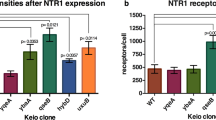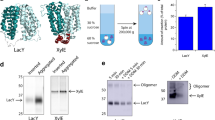Abstract
P-glycoprotein (pgp) is a membrane transport protein that causes multidrug resistance (MDR) by actively extruding a wide variety of cytotoxic agents out of cells. It may also function as a peptide transporter, a volume-regulated chloride channel, and an ATP channel. Previously, it has been shown that hamster pgp1 Pgp is expressed in more than one topological form and that the generation of these structures is modulated by charged amino acids flanking the predicted transmembrane (TM) segments 3 and 4 and by soluble cytoplasmic factors. Different topological structures of Pgp may be related to its different functions. In this study, we examined the effects of translation temperature on the membrane insertion process and the topologies of Pgp. Using the rabbit reticulocyte lysate expression system, we showed that translation at different temperatures affects the membrane insertion and orientation of the putative TM3 and TM4 of hamster pgp1 Pgp in a co-translational manner. This observation suggests that the membrane insertion process of TM3 and TM4 of Pgp molecules may involve a protein conducting channel and/or the interaction between TM3 and TM4, which act in a temperature sensitive manner. We speculate that manipulating temperature may provide a way to understand the structure-function relationship of Pgp and help overcome Pgp-related multidrug resistance of cancer cells.
Similar content being viewed by others
Abbreviations
- Pgp:
-
P-glycoprotein
- MDR:
-
multidrug resistance
- ABC:
-
ATP-binding cassette
- RRL:
-
rabbit reticulocyte lysate
- TM:
-
transmembrane
- RM:
-
rough microsomes
- ER:
-
endoplasmic reticulum
References
Endicott J A, Ling V: The biochemistry of P-glycoprotein-mediated multidrug resistance. Annu Rev Biochem 58:137–171, 1989
Gottesman MM, Pastan I: Biochemistry of multidrug resistance mediated by the multidrug transporter. Annu Rev Biochem 62: 385–427, 1993
Higgins CF: ABC transporters from microorganisms to man. Annu Rev Cell Biol 8: 67–113, 1992
Childs S, Ling V: The MDR superfamily of genes and its biological implications. In: V. T. DeVita, S. Hellman and S.A. Rosenberg (eds). Important Advances in Oncology. J.B. Lippincott Company, Philadelphia, 1994, pp 21–36
Sharma RC, Inuoe S, Roitelman J: Peptide transport by the multidrug resistance pump. J Biol Chem 267: 5731–5734, 1992
Valverde MA, Diaz M, Sepulveda FV, Gill DR, Hyde SC, Higgins CF: Volume-regulated chloride channels associated with the human multidrug-resistance P-glycoprotein. Nature 355: 830–833, 1992
Altenberg GA, Vanoye CG, Han ES, Deitmer JW, Reuss L: Relationship between rhodamine 123 transport, cell volume, and ion-channel function of P-glycoprotein. J Biol Chem 269: 7145–7149, 1994
Bear CE: Drug transported by P-glycoprotein inhibits a 40pS outwardly rectifying chloride channel. Biochem Biophys Res Comm 200: 513–521, 1994
Hardy SP, Goodfellow HR, Valverde MA, Gill DR, Sepulveda FV, Higgins CF: Protein kinase C-mediated phosphorylation of the human multidrug resistance P-glycoprotein regulates cell volume-activated chloride channels. EMBO J 14: 68–75, 1995
Abraham EH, Prat AG, Gerweck L, Seneveratne T, Arceci R, Kramer R, Guidotti G, Cantiello HF: The multidrug resistance (mdr1) gene product functions as an ATP channel. Proc Natl Acad Sci USA 90: 312–316, 1993
Zhang JT, Ling, V: Study of membrane orientation and glycosylated extracellular loops of mouse P-glycoprotein by in vitro translation. J Biol Chem 266: 18224–18232, 1991
Zhang JT, Duthie M, Ling V: Membrane topology of the N-terminal half of the hamster P-glycoprotein molecule. J Biol Chem 268: 15101–15110, 1993
Skach WR, Calayag MC, Lingappa VR: Evidence for an alternate model of human P-glycoprotein structure and biogenesis. J Biol Chem 268: 6903–6908, 1993
Bibi E, Béjà O: Membrane topology of multidrug resistance protein expressed in Escherichia coli. J Biol Chem 269: 19910–19915, 1994
Skach, WR, Lingappa, VR: Transmembrane orientation and topogenesis of the third and fourth membrane-spanning regions of human P-glycoprotein (MDR1). Cancer Res 54: 3202–3209, 1994
Zhang JT, Lee CH, Duthie M, Ling V: Topological determinants of internal transmembrane segments in P-glycoprotein sequences. J Biol Chem 270: 1742–1746, 1995
Zhang JT, Ling V: Involvement of cytoplasmic factors regulating the membrane orientation of P-glycoprotein sequences. Biochemistry 34: 9159–9165, 1995
Kurjan J, Herskowitz I: Structure of a yeast pheromone gene (MFa): a putative α-factor precursor contains four tandem copies of mature α-factor. Cell 30: 933–943, 1982
Waters M.G, Blobel G: Secretory protein translocation in a yeast cell-free system can occur posttranslationally and requires ATP hydrolysis. J Cell Biol 102: 1543–1550, 1986
Rothblatt JA, Meyer DI: Secretion in yeast: translocation and glycosylation of prepro-α-factor in vitro can occur via an ATP-dependent post-translational mechanism. EMBO J 5: 1031–1036, 1986
Hansen W, Garcia PD, Walter P: In vitro protein translocation across the yeast endoplasmic reticulum: ATP-dependent posttranslational translocation of the prepro-α-factor. Cell 45: 397–406, 1986
Simon SM, Blobel G: A protein-conducting channel in the endoplasmic reticulum. Cell 65: 371–380, 1991
Loo TW, Clarke DM: Membrane topology of a cysteine-less mutant of human P-glycoprotein J Biol Chem 270: 843–848, 1995
Zhang M, Zhang JT: Evidence for the expression of multiple topologies of P-glycoprotein in multidrug resistant CHRB30 cells. Proceedings of American Association for Cancer Research 36: 337a, 1995
Cheng SH, Gregory RJ, Marshall J, Paul S, Souza DW, White GA, O'Riordan CR, Smith AE: Defective intracellular transport and processing of CFTR is the molecular basis of most cystic fibrosis. Cell 63: 827–834, 1990
Thomas PJ, Shenbagamurthi P, Sondek J, Hullihen JM, Pedersen PL: The cystic fibrosis transmembrane conductance regulator: effects of the most common cystic fibrosis-causing mutation on the secondary structure and stability of a synthetic peptide. J Biol Chem 267: 5727–5730, 1992
Dalemans W, Barbry P, Champigny G, Jallat S, Dott K, Dreyer D, Crystal RG, Pavirani A, Lecoeq JP, Lazdunski M: Altered chloride ion channel kinetics associated with ΔF508 cystic fibrosis mutation. Nature 354: 526–528, 1991
Denning GM, Anderson MP, Amara JF, Marshall J, Smith AE, Welsh JJ: Processing of mutant CFTR (4F508) is temperature sensitive. Nature 358: 761–764, 1992
Drumm ML, Wilkinson DJ, Smit LS, Worrell RT, Strong TV, Frizzell RA, Dawson DC, Collins FS: Chloride conductance expressed by ΔDF508 and other mutant CFTRs in Xenopus oocytes. Science 254: 1797–1799, 1991
Bates DA, Mackillop WJ: Hyperthermia, adriamycin transport, and cytotoxicity in drug-sensitive and -resistant Chinese hamster ovary cells. Cancer Res 46: 5477–5481, 1986
Loo TW, Clarke DM: Prolonged association of temperature-sensitive mutants of human P-glycoprotein with calnexin during biogenesis. J Biol Chem 269: 28683–28689, 1994
Hochachka PW, Somero GN: Strategies of biochemical adaptation. W.B. Saunders, Philadelphia, 1973, pp 180–181
Author information
Authors and Affiliations
Rights and permissions
About this article
Cite this article
Zhang, JT., Chong, C.H. Co-translational effects of temperature on membrane insertion and orientation of P-glycoprotein sequences. Mol Cell Biochem 159, 25–31 (1996). https://doi.org/10.1007/BF00226059
Received:
Accepted:
Issue Date:
DOI: https://doi.org/10.1007/BF00226059




